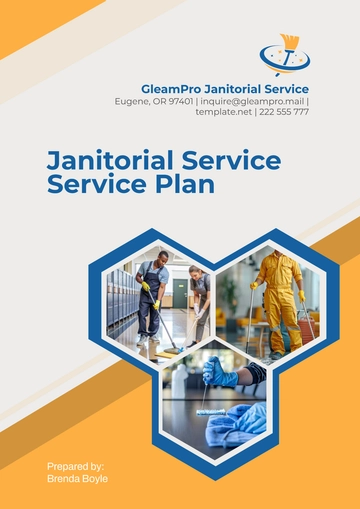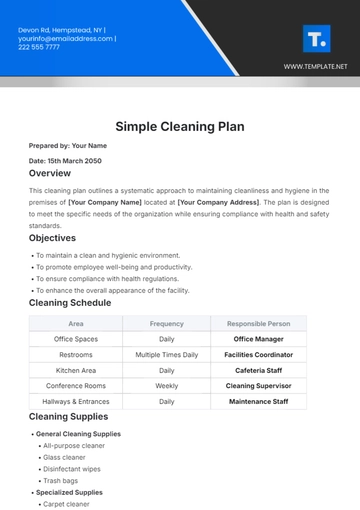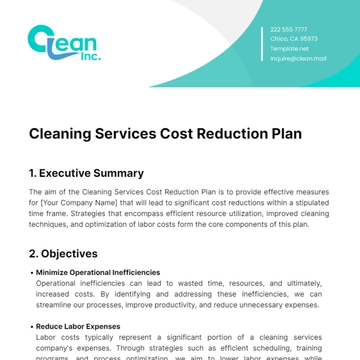Free Cleaning Services Waste Management Operational Plan

I. Executive Summary
In our ongoing commitment to environmental stewardship and operational excellence, we have developed a comprehensive Cleaning Services Waste Management Operational Plan. This document outlines our strategic approach to managing the waste generated through our cleaning operations, aiming to minimize our environmental footprint while maintaining high-quality service. Our objectives include reducing the volume of waste produced, increasing the proportion of waste that is recycled or reused, and ensuring the responsible disposal of waste. Through this plan, we aim to achieve compliance with all relevant environmental regulations, enhance our operational efficiency, and contribute positively to the communities we serve.
II. Company Overview
Founded on a dedication to excellence and sustainability, [Your Company Name] has grown from a small, locally-focused cleaning service to a leader in the industry. We offer a wide range of cleaning services tailored to meet the needs of our diverse clientele, including residential, commercial, and specialized cleaning. Our team is trained in the latest eco-friendly cleaning techniques and practices, reflecting our commitment to reducing environmental impact. With operations across multiple locations, we strive to deliver services that not only meet but exceed the expectations of our clients while actively contributing to the preservation of the planet.
III. Regulatory Compliance and Standards
Ensuring compliance with all applicable environmental regulations is a cornerstone of our waste management strategy. Our operations adhere to a strict framework of standards and practices designed to minimize waste and prevent pollution. Key regulatory standards that guide our waste management practices include:
A. Resource Conservation and Recovery Act (RCRA): This federal law provides the framework for the proper management of hazardous and non-hazardous solid waste. Our policies are designed to ensure that waste generated from our cleaning services is identified, stored, treated, and disposed of in compliance with RCRA guidelines.
B. Occupational Safety and Health Administration (OSHA) Standards: We comply with OSHA regulations related to hazardous waste operations and emergency response. This includes training our staff in safe handling practices for cleaning chemicals and materials that could pose hazards.
C. Environmental Protection Agency (EPA) Guidelines: The EPA's guidelines on waste management and reduction are integral to our operational practices. This includes adhering to the EPA's recommendations for the use of environmentally friendly cleaning products and the proper disposal of waste materials.
D. State and Local Environmental Regulations: In addition to federal regulations, we abide by state and local environmental laws that govern waste management. This ensures that our practices are not only compliant on a national level but also meet the specific requirements of the communities in which we operate.
IV. Waste Audit and Assessment
To develop a baseline for our waste management efforts and identify areas for improvement, we conduct comprehensive waste audits and assessments on a semi-annual basis. These audits involve the systematic collection and analysis of data regarding the types, volumes, and sources of waste generated through our cleaning operations. Our methodology includes sorting waste into categories (e.g., recyclables, non-recyclables, hazardous), weighing, and documenting the waste, and then analyzing these findings to identify patterns and opportunities for waste reduction.
Waste | Average Volume (Monthly) | Percentage of Total Waste | Notes |
Recyclables | 500 kg | 40% | Primarily paper, plastic, and metal. |
Non-recyclables | 600 kg | 50% | Mostly disposable cleaning materials. |
Hazardous | 100 kg | 10% | Includes spent cleaning chemicals. |
The data from our latest waste audit reveals that a significant portion of our waste is recyclable, highlighting an opportunity to enhance our recycling efforts. The high volume of non-recyclable waste prompts us to explore alternatives, such as biodegradable or reusable cleaning supplies. The hazardous waste component, while smaller, underscores the importance of proper handling, storage, and disposal practices to mitigate environmental and health risks.
V. Waste Reduction Strategies
In response to our waste audit findings, we have implemented several targeted strategies to minimize the waste generated by our cleaning operations. Our approach encompasses reducing the use of disposable materials, increasing recycling, and educating our workforce on sustainable practices.
A. Implement Eco-friendly Cleaning Supplies: Switch to biodegradable, reusable, or recyclable cleaning materials wherever possible to reduce the generation of non-recyclable waste.
B. Enhance Recycling Programs: Increase the segregation and recycling of paper, plastic, and metal waste by providing more accessible and clearly labeled recycling bins at all operational sites.
C. Employee Training Programs: Conduct regular training sessions for our staff on waste reduction techniques and the environmental impact of waste, fostering a culture of sustainability within our workforce.
D. Client Engagement: Work with clients to identify and implement waste reduction opportunities in their cleaning service requirements, including the use of environmentally friendly products and practices.
E. Reduce Hazardous Waste: Minimize the use of hazardous cleaning chemicals by substituting them with environmentally friendly alternatives and implement strict control measures for the handling and disposal of hazardous waste.
VI. Waste Handling and Storage
Proper waste handling and storage are crucial for ensuring the safety of our employees, clients, and the environment. We adhere to a set of guidelines designed to optimize our waste management operations and comply with regulatory standards.
A. Segregate Waste at the Source: Ensure that waste is separated into recyclables, non-recyclables, and hazardous categories at the point of generation to facilitate efficient recycling and disposal.
B. Label Waste Containers Clearly: Use clear, understandable labels and color-coded bins to help staff correctly identify and segregate waste, reducing the risk of contamination.
C. Store Hazardous Waste Securely: Keep hazardous waste in specially designated, secure containers to prevent leaks and accidental exposure, in accordance with regulatory requirements.
D. Conduct Regular Inspections: Perform routine inspections of waste storage areas to identify and correct potential issues such as overfilling or improper segregation.
E. Train Staff in Safe Handling Practices: Provide ongoing training to all employees on the correct procedures for handling and storing different types of waste, emphasizing safety and environmental protection.
VII. Recycling and Disposal
A. Recyclable Waste Materials
Identifying and properly managing recyclable waste materials is a key component of our waste management strategy. We train our staff to recognize materials that can be recycled, including paper, cardboard, certain plastics, metals, and glass. These materials are separated from general waste at the source and collected in designated recycling bins. Our recycling partners then process these materials, ensuring they are reused, thus reducing the demand for raw materials and minimizing our environmental footprint.
Paper and cardboard
Plastics (as per local recycling guidelines)
Metals (aluminum cans, tin cans)
Glass bottles and jars
Electronic waste (e-waste) in specific cases
B. Disposal of Non-Recyclable Waste
For waste materials that cannot be recycled, we adhere to a set of guidelines to ensure their responsible and efficient disposal. This approach minimizes our impact on landfill space and the environment.
Minimize Generation: Prioritize the reduction of non-recyclable waste generation through the use of alternative materials and methods.
Use Designated Bins: Dispose of non-recyclable waste in clearly labeled, designated bins to prevent contamination of recyclable materials.
Compact Waste to Reduce Volume: Where possible, compact waste to minimize its footprint and reduce transportation emissions.
Employ Licensed Waste Disposal Services: Ensure that all non-recyclable waste is collected and disposed of by licensed and environmentally responsible waste management companies.
C. Special Considerations
Certain types of waste require special handling and disposal methods to protect public health and the environment. This includes hazardous waste and sensitive documents that may contain personal or confidential information.
Follow Legal Requirements for Hazardous Waste: Adhere to all local, state, and federal regulations for the handling, storage, and disposal of hazardous waste materials.
Securely Destroy Sensitive Documents: Use cross-cut shredders or professional document destruction services to ensure the confidentiality of sensitive information.
Handle Electronic Waste Properly: Engage certified e-waste recyclers to dispose of electronic waste, such as computers and smartphones, in an environmentally safe manner.
VIII. Monitoring and Reporting
To ensure the effectiveness of our waste management practices and maintain compliance with environmental regulations, we have implemented a comprehensive monitoring and reporting system.
Track Waste Generation and Diversion Rates: Regularly monitor and record the volume of waste generated, as well as the amount diverted through recycling and reuse efforts.
Conduct Regular Audits: Perform periodic audits of waste management practices at all operational sites to identify areas for improvement and ensure compliance with internal policies and regulatory requirements.
Report to Regulatory Authorities: Submit required waste management reports to local, state, and federal environmental agencies in accordance with legal obligations.
Engage Employees: Encourage feedback from employees on waste management practices and suggestions for improvement.
Review and Update the Waste Management Plan: Annually review the effectiveness of the waste management plan and update it as necessary to reflect changes in operations, regulations, or best practices.
IX. Training and Communication
Ensuring that all team members are knowledgeable about and committed to our waste management practices is essential for the success of our plan. To achieve this, we have established a comprehensive training and communication program that covers waste reduction techniques, proper waste segregation, handling and storage practices, recycling processes, and the environmental impact of waste.
Program Topic | Frequency | Duration |
Waste Reduction Techniques | Bi-annually | 2 hours |
Proper Segregation and Handling | Quarterly | 1 hour |
Safe Storage Practices | Annually | 1 hour |
Recycling Processes | Bi-annually | 1.5 hours |
Environmental Impact Awareness | Annually | 1 hour |
Hazardous Waste Management | As needed | 2 hours |
This training ensures that all employees are equipped with the knowledge and skills necessary to effectively contribute to our waste management objectives. Additionally, we leverage internal newsletters, emails, and meetings to communicate updates, share successes, and reinforce the importance of everyone's role in waste management.
X. Review and Continuous Improvement
Our Cleaning Services Waste Management Operational Plan is a living document that reflects our commitment to environmental stewardship and operational excellence. To ensure that our waste management practices remain effective and relevant, we will review and update this plan annually. This review process will consider changes in regulatory requirements, advancements in waste management technologies, feedback from employees and clients, and our waste management performance metrics. By committing to this cycle of continuous improvement, we aim to enhance our environmental performance, adapt to new challenges and opportunities, and uphold our reputation as a responsible and sustainable cleaning services provider.
- 100% Customizable, free editor
- Access 1 Million+ Templates, photo’s & graphics
- Download or share as a template
- Click and replace photos, graphics, text, backgrounds
- Resize, crop, AI write & more
- Access advanced editor
Unlock efficient waste management with the Cleaning Services Waste Management Operational Plan Template from Template.net. This editable and customizable template streamlines your planning process, ensuring environmental compliance and operational efficiency. Perfectly structured for cleaning services, it's editable in our AI Editor tool, making it an essential tool for your business's sustainability efforts.
You may also like
- Finance Plan
- Construction Plan
- Sales Plan
- Development Plan
- Career Plan
- Budget Plan
- HR Plan
- Education Plan
- Transition Plan
- Work Plan
- Training Plan
- Communication Plan
- Operation Plan
- Health And Safety Plan
- Strategy Plan
- Professional Development Plan
- Advertising Plan
- Risk Management Plan
- Restaurant Plan
- School Plan
- Nursing Home Patient Care Plan
- Nursing Care Plan
- Plan Event
- Startup Plan
- Social Media Plan
- Staffing Plan
- Annual Plan
- Content Plan
- Payment Plan
- Implementation Plan
- Hotel Plan
- Workout Plan
- Accounting Plan
- Campaign Plan
- Essay Plan
- 30 60 90 Day Plan
- Research Plan
- Recruitment Plan
- 90 Day Plan
- Quarterly Plan
- Emergency Plan
- 5 Year Plan
- Gym Plan
- Personal Plan
- IT and Software Plan
- Treatment Plan
- Real Estate Plan
- Law Firm Plan
- Healthcare Plan
- Improvement Plan
- Media Plan
- 5 Year Business Plan
- Learning Plan
- Marketing Campaign Plan
- Travel Agency Plan
- Cleaning Services Plan
- Interior Design Plan
- Performance Plan
- PR Plan
- Birth Plan
- Life Plan
- SEO Plan
- Disaster Recovery Plan
- Continuity Plan
- Launch Plan
- Legal Plan
- Behavior Plan
- Performance Improvement Plan
- Salon Plan
- Security Plan
- Security Management Plan
- Employee Development Plan
- Quality Plan
- Service Improvement Plan
- Growth Plan
- Incident Response Plan
- Basketball Plan
- Emergency Action Plan
- Product Launch Plan
- Spa Plan
- Employee Training Plan
- Data Analysis Plan
- Employee Action Plan
- Territory Plan
- Audit Plan
- Classroom Plan
- Activity Plan
- Parenting Plan
- Care Plan
- Project Execution Plan
- Exercise Plan
- Internship Plan
- Software Development Plan
- Continuous Improvement Plan
- Leave Plan
- 90 Day Sales Plan
- Advertising Agency Plan
- Employee Transition Plan
- Smart Action Plan
- Workplace Safety Plan
- Behavior Change Plan
- Contingency Plan
- Continuity of Operations Plan
- Health Plan
- Quality Control Plan
- Self Plan
- Sports Development Plan
- Change Management Plan
- Ecommerce Plan
- Personal Financial Plan
- Process Improvement Plan
- 30-60-90 Day Sales Plan
- Crisis Management Plan
- Engagement Plan
- Execution Plan
- Pandemic Plan
- Quality Assurance Plan
- Service Continuity Plan
- Agile Project Plan
- Fundraising Plan
- Job Transition Plan
- Asset Maintenance Plan
- Maintenance Plan
- Software Test Plan
- Staff Training and Development Plan
- 3 Year Plan
- Brand Activation Plan
- Release Plan
- Resource Plan
- Risk Mitigation Plan
- Teacher Plan
- 30 60 90 Day Plan for New Manager
- Food Safety Plan
- Food Truck Plan
- Hiring Plan
- Quality Management Plan
- Wellness Plan
- Behavior Intervention Plan
- Bonus Plan
- Investment Plan
- Maternity Leave Plan
- Pandemic Response Plan
- Succession Planning
- Coaching Plan
- Configuration Management Plan
- Remote Work Plan
- Self Care Plan
- Teaching Plan
- 100-Day Plan
- HACCP Plan
- Student Plan
- Sustainability Plan
- 30 60 90 Day Plan for Interview
- Access Plan
- Site Specific Safety Plan














